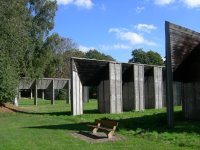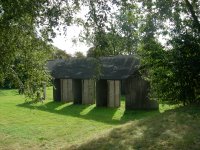The Fortsmonth came to an end more than one month ago and still didn't post the last part of the last fort that we visited on September 30th. The only excuse I have is that I was quite busy. The past weekend I went to the Dejima Japanese Film Festival in Amsterdam on Friday and Saturday and on Sunday to the Holland Animation Film Festival in my hometown Utrecht to see two Japanese animation films. I saw a total of 9 movies the past weekend. Not a bad average. In the weeks since my last post until Friday I was busy with all kinds of other stuff, which I'm not going to bore you with. Let's tell something about the fort.
The last fort we visited was Fort De Bilt. Although I found most forts interesting to visit I found Fort de Bilt together with Fort Rijnauwen, Fort Pampus and Fort Hinderdam (sorry only Dutch) the most interesting. During the German occupation at World War 2 a lot of forts were only used for storage purposes. But Fort Rijnauwen and Fort De Bilt were also used as an execution place were people from the resistance and other prisoners were shot. In both forts there are monuments that remind of the people who were shot by the Germans. In this post you can see the monument in pictures 9, 10, 11 and 12.
The monument was put on the actual executionplace. Next to the executionplace in picture 6, 7 and 8 you can see some details from the bunker were the unfortunate prisoners spend their last night before they were shot the next morning. You could go inside this bunker and it gave me a strange and weird feeling, wondering what all those people must have thought during their last night before they would face their firing squad. A total of 140 people were shot at this place. Their names are carved on the stone shown in picture 9. Among the victims there were also a few teenagers, only 18 years old. Every year the day before Liberationday, on May 4th, our national memorial day for the people who got killed in World War 2 there is a short rememberance service at this monument, also at the monument at Fort Rijnauwen.
Short after the war the fort was used for a few years as prisoncamp for collaborators and members of the Dutch National Socialist Movement (NSB). A few years ago a memorial centre for the future and for peace education was developed, especially for children. They organized a (more or less, I think) permanent interactive exhibition about prejudices, scapegoats, bullying and the resistance during the Second World War and present day.
If you look at the picture from Google Earth you see that the current fort is cross out by a road. The part on the top is the part of the fort that is open to visitors. The fort part below is now in use by the military police.
For now this is my last post for a while about the forts of the Hollandse Waterlinie (Dutch Waterline). But I'm pretty sure we will visit other forts next year. Enjoy the pics.
The last fort we visited was Fort De Bilt. Although I found most forts interesting to visit I found Fort de Bilt together with Fort Rijnauwen, Fort Pampus and Fort Hinderdam (sorry only Dutch) the most interesting. During the German occupation at World War 2 a lot of forts were only used for storage purposes. But Fort Rijnauwen and Fort De Bilt were also used as an execution place were people from the resistance and other prisoners were shot. In both forts there are monuments that remind of the people who were shot by the Germans. In this post you can see the monument in pictures 9, 10, 11 and 12.
The monument was put on the actual executionplace. Next to the executionplace in picture 6, 7 and 8 you can see some details from the bunker were the unfortunate prisoners spend their last night before they were shot the next morning. You could go inside this bunker and it gave me a strange and weird feeling, wondering what all those people must have thought during their last night before they would face their firing squad. A total of 140 people were shot at this place. Their names are carved on the stone shown in picture 9. Among the victims there were also a few teenagers, only 18 years old. Every year the day before Liberationday, on May 4th, our national memorial day for the people who got killed in World War 2 there is a short rememberance service at this monument, also at the monument at Fort Rijnauwen.
Short after the war the fort was used for a few years as prisoncamp for collaborators and members of the Dutch National Socialist Movement (NSB). A few years ago a memorial centre for the future and for peace education was developed, especially for children. They organized a (more or less, I think) permanent interactive exhibition about prejudices, scapegoats, bullying and the resistance during the Second World War and present day.
If you look at the picture from Google Earth you see that the current fort is cross out by a road. The part on the top is the part of the fort that is open to visitors. The fort part below is now in use by the military police.
For now this is my last post for a while about the forts of the Hollandse Waterlinie (Dutch Waterline). But I'm pretty sure we will visit other forts next year. Enjoy the pics.
Inside there is nothing of any value.





















3 comments:
Klopt het dat ik hier geen foto's van Fort Pannerden vind? Maakt dat geen deel uit van de NHW?
Jawel, maar de NHW bestaat uit meer dan 80 grotere en wat kleinere forten. Wij hebben daar nog maar een fractie van gezien, hooguit een 20, 25 procent. We kunnen nog wel even vooruit. :-)
En dan durven sommige mensen nog te zeggen dat er in Nederland niks te beleven valt ;-)
Post a Comment